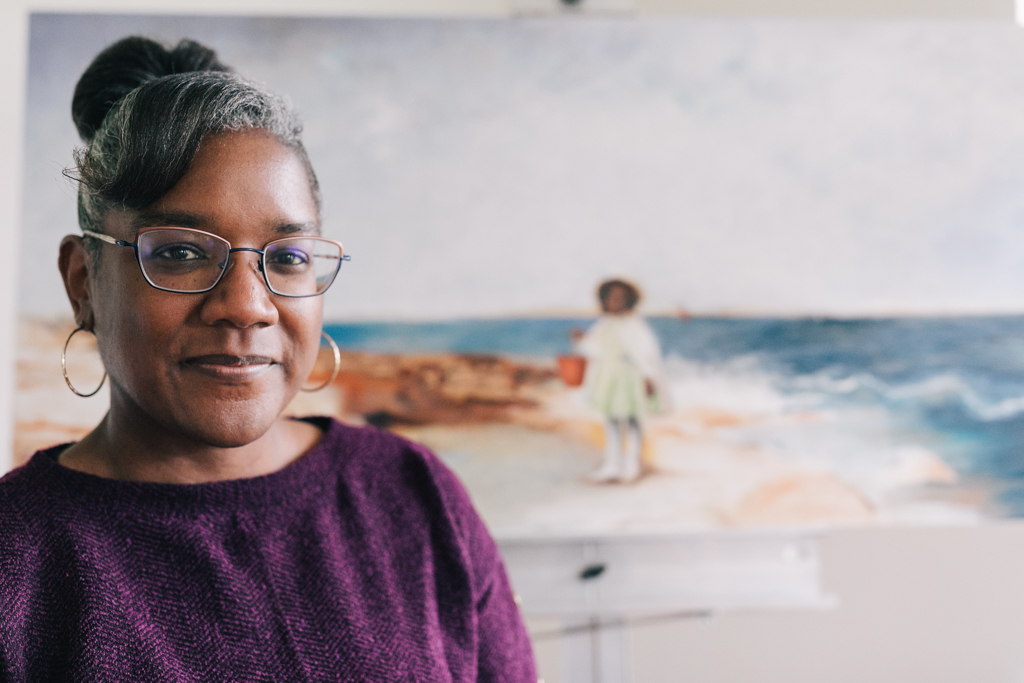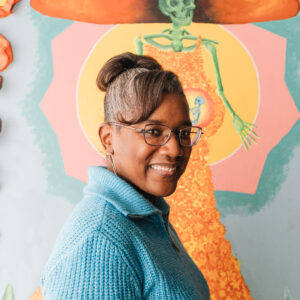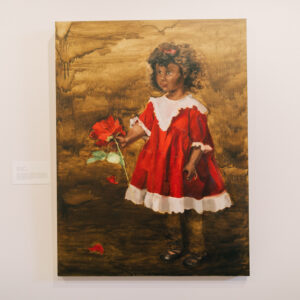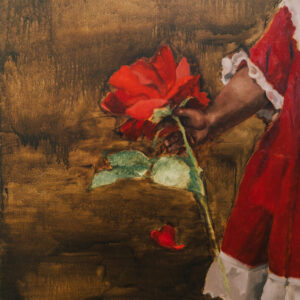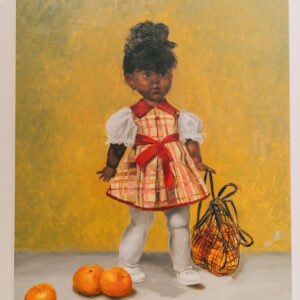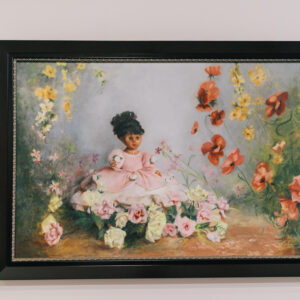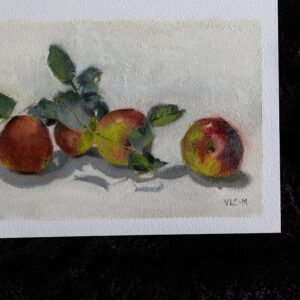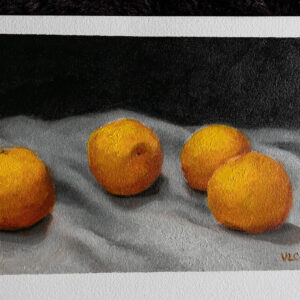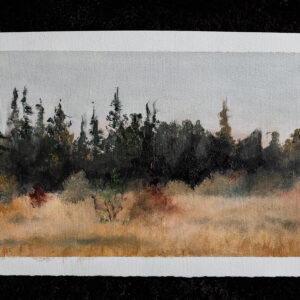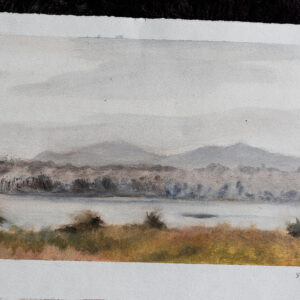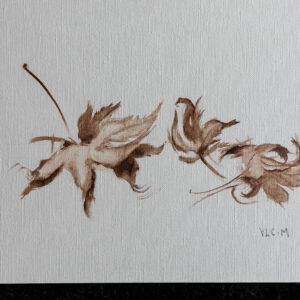Valencia Carroll is a passionate and dedicated teaching artist who believes deeply in the
transformative power of art. With a diverse background in fine arts and art therapy, Valencia
integrates her love for creativity with her commitment to teaching, inspiring and
empowering students of all ages, abilities, and backgrounds through art.
Early in her art career, Valencia earned a Master’s degree in Art Therapy from The
George Washington University in Washington, DC. She then went on to hone her craft as a
classically trained oil painter during four years of intensive study at the renowned Aristides
Atelier at the Gage Academy of Art in Seattle, WA. There, she refined her skills in drawing and
painting, further laying the foundation for her multifaceted approach to teaching.
Valencia is committed to continuous growth and development as an educator. She actively seeks
out opportunities to enhance her teaching skills, including training in programs such as the
Teaching Artist Training (TAT) Lab based in Seattle and participating in professional development workshops. Through these experiences, she deepens her understanding of effective teaching, ensuring that she remains at the forefront of art education. Throughout her career, Valencia has worked with diverse communities in both formal and informal educational settings. Whether leading workshops in schools, community centers, and public libraries or teaching art classes at museums and cultural institutions, she has left an indelible mark on countless students with her engaging and inclusive teaching style.
Valencia’s teaching philosophy is centered around creating a supportive and inclusive learning environment where students feel empowered to explore their creativity, take risks, and express themselves authentically. She believes in nurturing each student’s individual strengths and interests while providing a solid foundation of technical skills and artistic principles.
In addition to her role as a teaching artist, Valencia is an accomplished visual artist with a portfolio that primarily focuses on her passion for oil painting where she experiments with lighting, color harmony and composition in her figurative, landscape and still-life works. Her dedication to her own artistic practice informs and enriches her teaching, allowing her to guide students through the creative process with empathy and expertise.
Whether facilitating meaningful discussions about art and society or sharing her own artistic journey, Valencia is dedicated to making a positive impact through art education. She firmly believes that art has the power to inspire, connect, and transform lives, and she is grateful for the opportunity to share that power with others.
Valencia is pictured with students working on a mural. Valencia is explaining a technique while pointing at the mural.
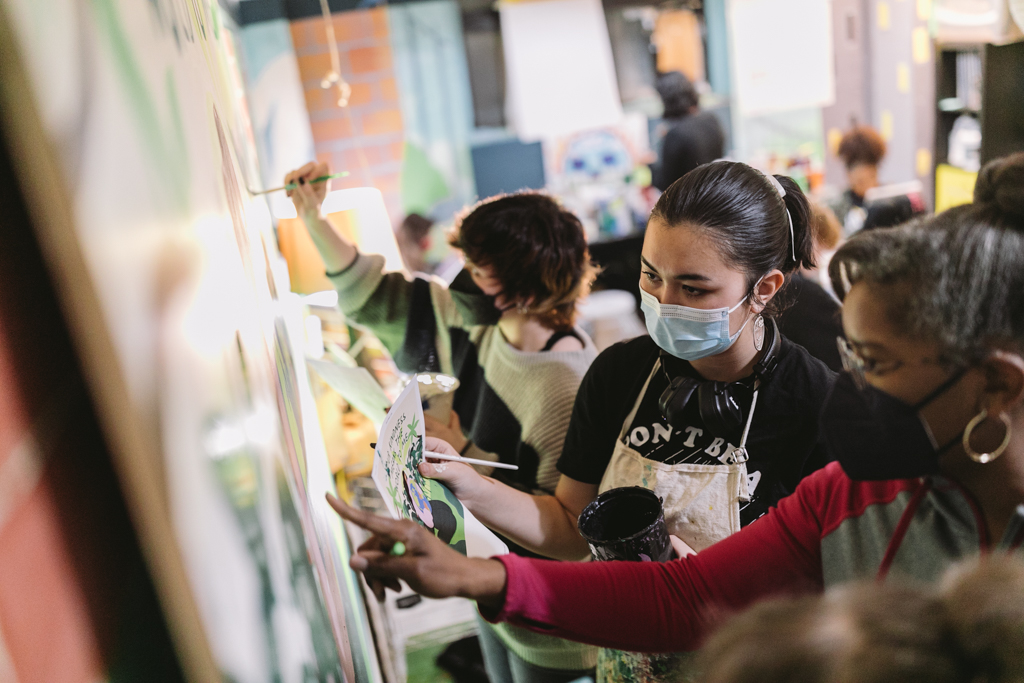
Tell us about your Urban ArtWorks involvement
My involvement with Urban ArtWorks began in 2022 when I was invited to participate in the Guest Artist Talk series for Base Crew. During this event, I had the privilege of sharing my most cherished experiences in public art as a practicing artist. Soon after, I assumed the role of Base Crew artist mentor, where I had the honor of providing personalized guidance to a young, aspiring artist, helping to shape their journey towards becoming a practicing artist following graduation from high school.
In addition to my mentoring role, I also served as a Base Crew Teaching Assistant, supporting young artists through every stage of the creative process in producing large-scale artworks. This included assisting with mural preparation, drawing transfer, and on-site painting for various community projects organized by Urban ArtWorks.
I am truly grateful for all of these experiences as they have provided me with the opportunity to nurture and inspire the next generation of artists.
Valencia is pictured working on a mural alongside Base Crew students.
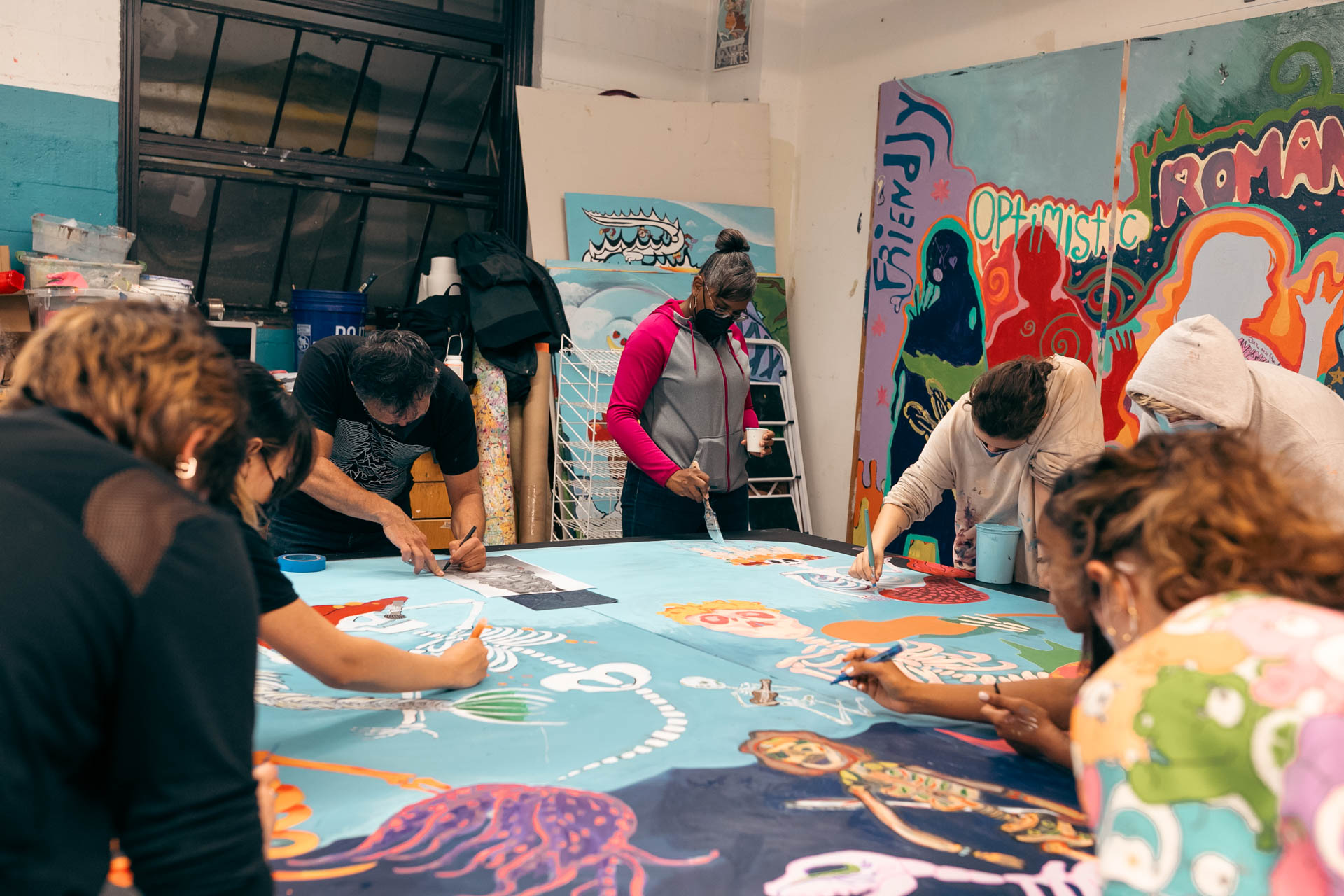
How did your early passion for art shape your decision to become a classically trained fine artist and teaching artist?
My early passion for art laid the foundation for my journey towards becoming a classically trained fine artist and teaching artist. It all began when I discovered the revered status of oil painting as the quintessential medium in fine art, known for its historical significance and longevity. Introduced to oil paints during my grade school years, I became captivated by the intricacies of the medium, from preparing the canvas to the final touches of varnishing and framing.
Simultaneously, my deep-seated desire to connect with others emerged during my formative years. Encouraged by an art teacher, I explored the field of art therapy, recognizing its potential to merge my love for art with a profound desire to help others. Pursuing a degree in art therapy and subsequently becoming a board-certified, registered art therapist, I found fulfillment in using art as a therapeutic tool to facilitate healing and self-expression.
However, my passion for art-making called me to explore further. I yearned to immerse myself fully in the creative process and make art my primary focus. In 2014, I was introduced to the world of “teaching art,” which seamlessly blended my artistic pursuits with my innate desire to connect with others in diverse settings. As a teaching artist, I found myself accessing communities and experiences that resonated deeply with my artistic goals and aspirations, allowing me to enrich the lives of others in a meaningful and profound way.
Valencia is sitting in front of a mural she is working on, and looking out the window.
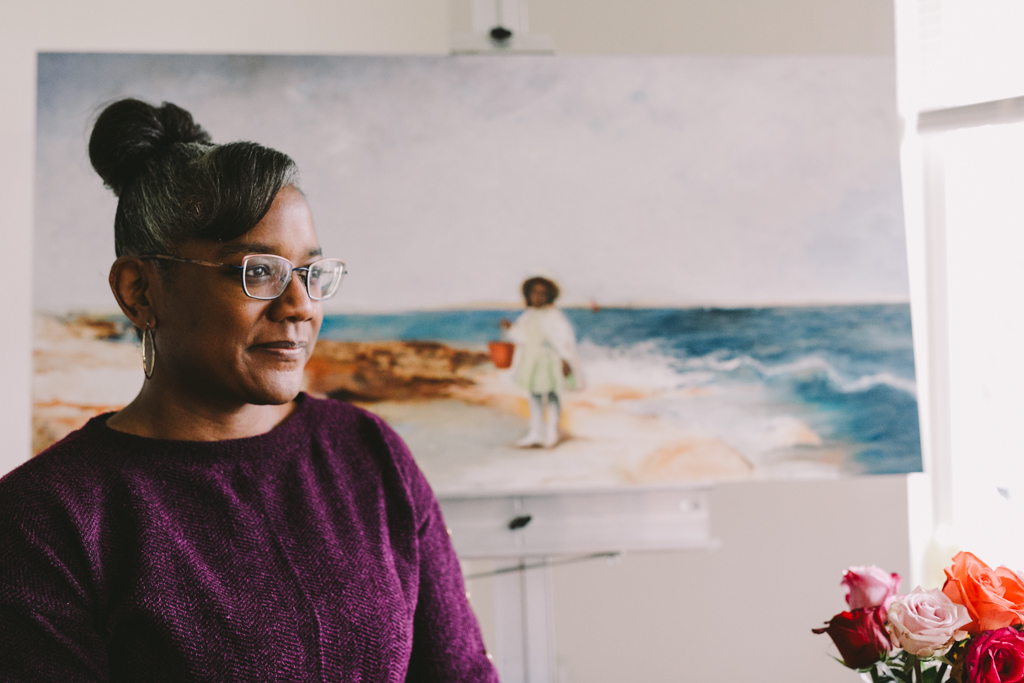
Can you share a memorable moment or experience as a Teaching Artist or Muralist with Urban ArtWorks that had an impact on you?
One particularly memorable experience as a Teaching Artist and Muralist with Urban ArtWorks occurred during the fall of 2023. Witnessing the Base Crew students enthusiastically embrace the challenge of translating their ideas from sketches in their art journals to large-scale murals in the ground floor entryway of the Inscape Arts building was incredibly inspiring.
Despite facing the daunting task of completing their projects within a tight deadline of less than three weeks and the initial uncertainty of their murals being whitewashed afterward, the students exhibited remarkable dedication and courage throughout the process.
Their unwavering commitment to their work, coupled with their determination to see their visions come to fruition, was both heartening and moving. Despite the potential outcome, they poured their hearts and souls into their creations, ultimately producing stunning results. This remarkable display of perseverance and creativity did not go unnoticed, as other resident artists of the Inscape Arts community recognized and appreciated the students’ intense work ethic and the artwork was allowed to remain indefinitely.
In the end, the murals surpassed expectations and left a lasting impression on all who encountered them. It was incredibly rewarding to witness the students’ perseverance culminate in such remarkable accomplishments. This experience serves as a testament to the transformative power of art and the profound impact it can have on individuals and communities alike.
Images of Valencia’s paintings
Can you share a memorable moment or experience as a Teaching Artist or Muralist with Urban ArtWorks that changed your perspective on something?
One transformative moment during my time mentoring for Base Crew with Urban ArtWorks came when a student shared her frustration about the transient nature of public art. She described the disheartening experience of returning to a mural, meticulously crafted with fellow student artists, only to find it tagged or damaged by individuals unrelated to the project. This ongoing cycle of repair and collaboration with peers who didn’t always align with her vision left her feeling frustrated and disillusioned.
This experience profoundly shifted my perspective on the impermanence of public art. Coming from a background rooted in studio art, where pieces are revered and preserved, I had never fully grasped the ephemeral nature of artworks in public spaces. Witnessing how external factors, whether human or natural, could alter or even destroy painstakingly created works opened my eyes to the fluidity of art in the public sphere.
Despite the challenges and setbacks, what struck me most was the resilience and adaptability of the students. Instead of becoming discouraged by the transient nature of their creations, they embraced change and adversity as inherent parts of the artistic process. This realization challenged my preconceptions about the permanence of art and underscored the importance of embracing evolution and growth, even in the face of adversity.
Valencia standing inside the Black Artists Exhibition alongside her painting exhibited at Tacoma Community College.
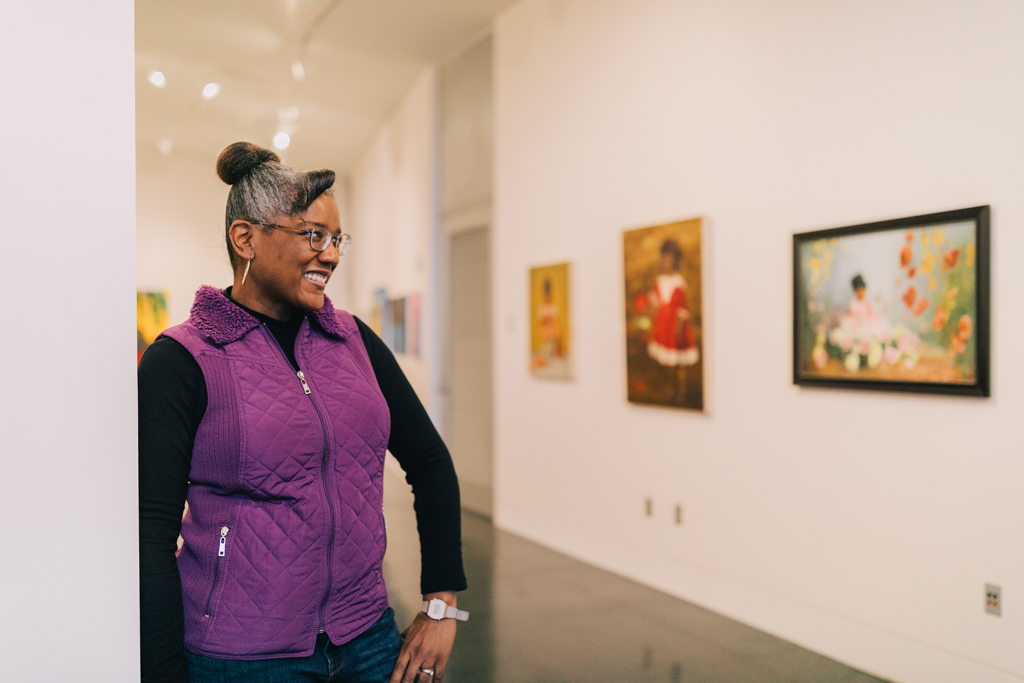
Considering your high school mentorship and the creation of a great white shark mural in your hometown marine museum, how did that experience influence your approach to teaching art to your students?
My experience as an intern assistant painting a larger-than-life mural at my hometown marine museum was truly transformative and profoundly shaped my approach to teaching art. This opportunity provided me with invaluable real-world experience that went beyond anything I could have imagined at the time. Engaging in hands-on work and being part of the behind-the-scenes process – from initial sketches to underpainting and finally to the completion of the mural – taught me the evolution of ideas into fully realized artworks.
Witnessing how small sketches could evolve and grow into magnificent finished pieces was a revelation. It highlighted the importance of iterative creation and the power of persistence in the artistic process. Even more so, this experience instilled in me the significance of maintaining a sketchbook as a professional artist. Sketches and reference materials became indispensable tools throughout the project, serving as constant sources of inspiration and guidance.
Through my high school mentorship and involvement in such a monumental project, I gained invaluable insights into the transformative potential of hands-on learning and the profound impact of real-world experiences on artistic development. These lessons continue to inform my approach to teaching art, inspiring me to cultivate creativity, resilience, and a deep appreciation for the journey of artistic creation in my students.
Valencia working on a painting.
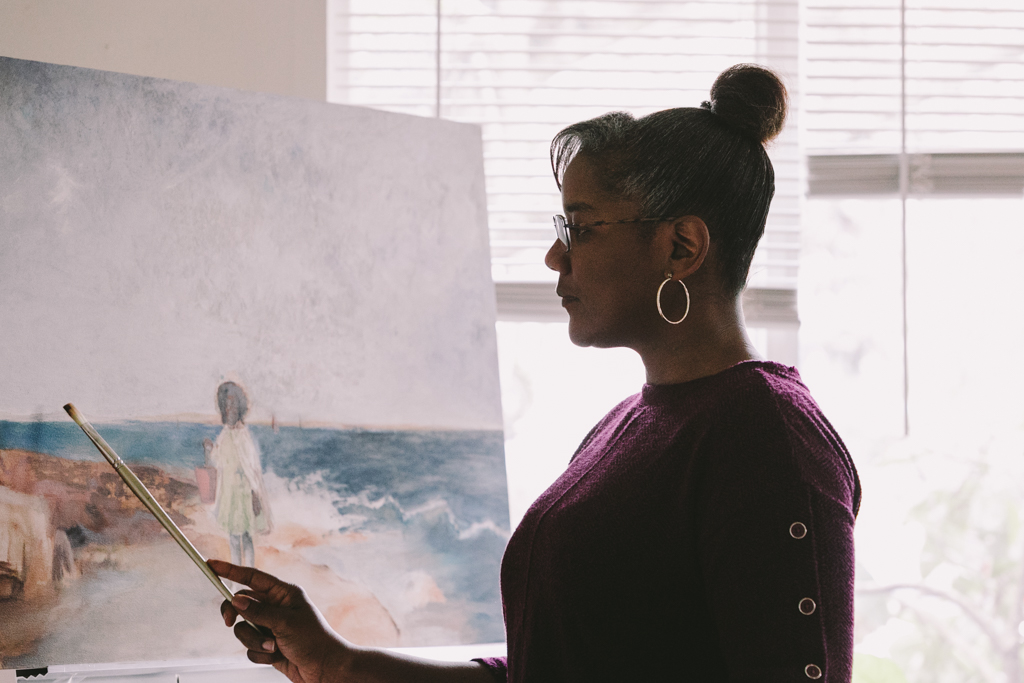
What inspired you to pursue a Master’s in Art Therapy at The George Washington University, and how has that background influenced your approach to teaching art?
I was inspired to pursue a Master’s in Art Therapy at The George Washington University after a conversation with my high school art teacher that took place four years earlier. During that conversation, I expressed my passion for both art and working with people. It was then that he suggested art therapy as a potential career path for me. His encouragement resonated deeply with me, igniting a desire to explore the intersection of art and psychology further. Building on his suggestion, I initially earned a BA in Clinical Psychology and minored in Studio Art. As my interest in art therapy persisted, it finally led me to ultimately pursue and obtain my MA in Art Therapy.
This background in art therapy has profoundly influenced my approach to teaching art. It has instilled in me a deep appreciation for the therapeutic power of artistic expression and the importance of creating a supportive and inclusive environment for students to explore their creativity. Drawing from my training in art therapy, I strive to foster a sense of trust and empathy in the classroom, encouraging students to use art as a tool for self-discovery, healing, and personal growth. By integrating principles of art therapy into my teaching practice, I aim to empower students to explore their emotions, experiences, and identities through art, promoting both artistic development and emotional well-being.
A portrait of Valencia, she is looking off to the side and there is light reflecting from a prism in the left side of the image.
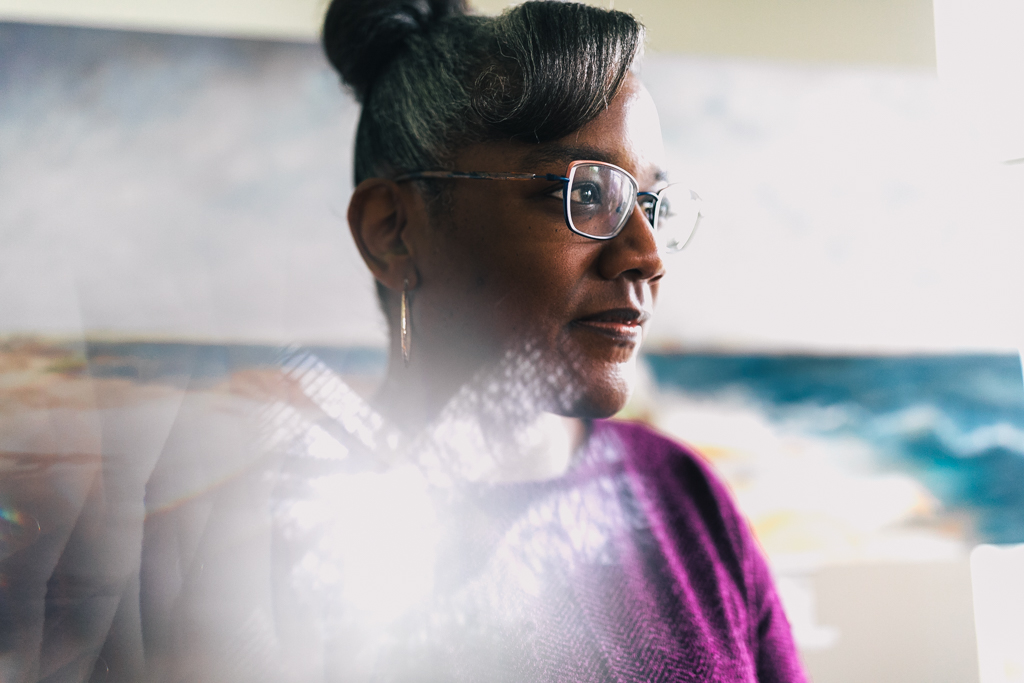
Could you tell us about your experiences as a Board-Certified Art Therapist, and artist with a Master’s in Art Therapy? how do you incorporate therapeutic elements into your teaching methods, fostering not just artistic skills but emotional well-being?
My experiences as a formerly practicing art therapist have greatly influenced my approach to teaching. I strive to strike a balance between fostering artistic skills and promoting emotional well-being through creative expression.
In my teaching methods, I emphasize both the process and the product of art-making. I encourage students to explore their creativity freely, experimenting with different techniques and mediums to develop their artistic skills. At the same time, I recognize the therapeutic potential of art and incorporate elements of self-expression and reflection into the creative process.
When creating public art, I aim to engage both the community and the artists involved in the project. I believe in creating meaningful experiences through art that not only beautify public spaces but also foster connections and evoke emotions. This involves collaboration, experimentation, and a focus on the artistic process, while also considering the final outcome and impact on the community.
By embracing both the artistic and therapeutic aspects of art-making, I aim to create enriching experiences that inspire creativity, promote emotional well-being, and contribute to the cultural vitality of communities.
Valencia is seated while she continues painting. There is a table of art supplies next to her. She is smiling.
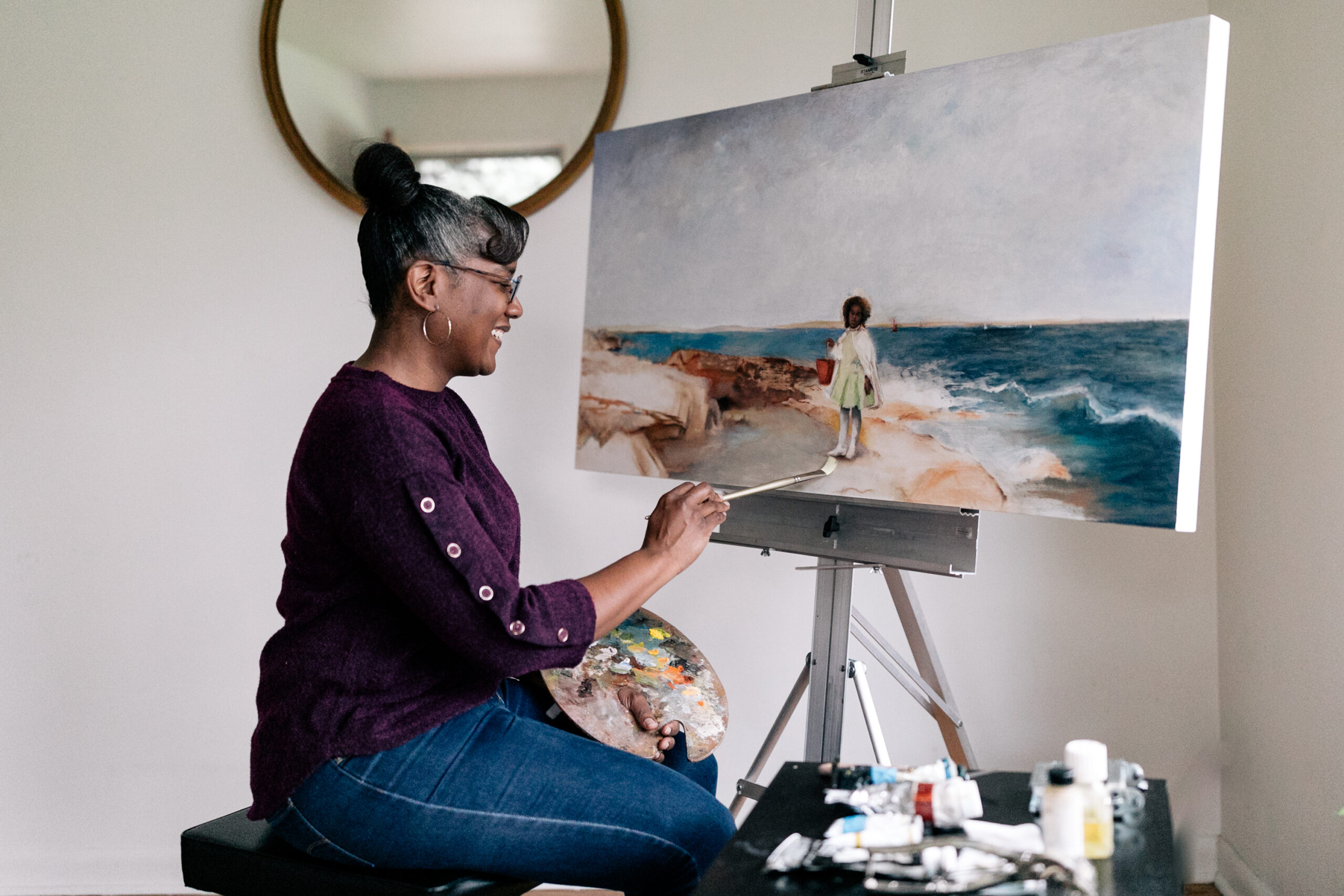
Urban ArtWorks focuses on public art projects. Can you discuss the challenges and rewards of guiding students in creating art that is not only personal but also contributes to the community?
Working with Urban ArtWorks on public art projects has been an incredibly rewarding experience that presents unique challenges and opportunities. One of the key challenges is guiding students to create art that not only reflects their personal vision but also resonates with and contributes to the broader community.
The challenge lies in balancing individual artistic expression with the collective vision of the community and assigned project. Encouraging students to infuse their personal creativity and style into their work while also ensuring that it aligns with the overarching goals and themes of the project requires careful navigation.
Despite these challenges, the rewards of guiding students in creating community-centric art are immense. Witnessing students’ growth and development as they collaborate with peers, engage with community members, and contribute to the beautification and revitalization of public spaces is truly gratifying.
Moreover, seeing the positive impact of their artwork on the community – whether it’s sparking conversations, fostering a sense of pride and ownership, or inspiring future generations of artists – reinforces the value of their efforts. Ultimately, guiding students in creating art that not only reflects their personal creativity but also contributes to the collective well-being of the community is a deeply fulfilling and enriching experience.
Valencia standing outside Tacoma Community College in front of the Black Artists Exhibition. A sign reads “Black Artists Exhibition” in the background.
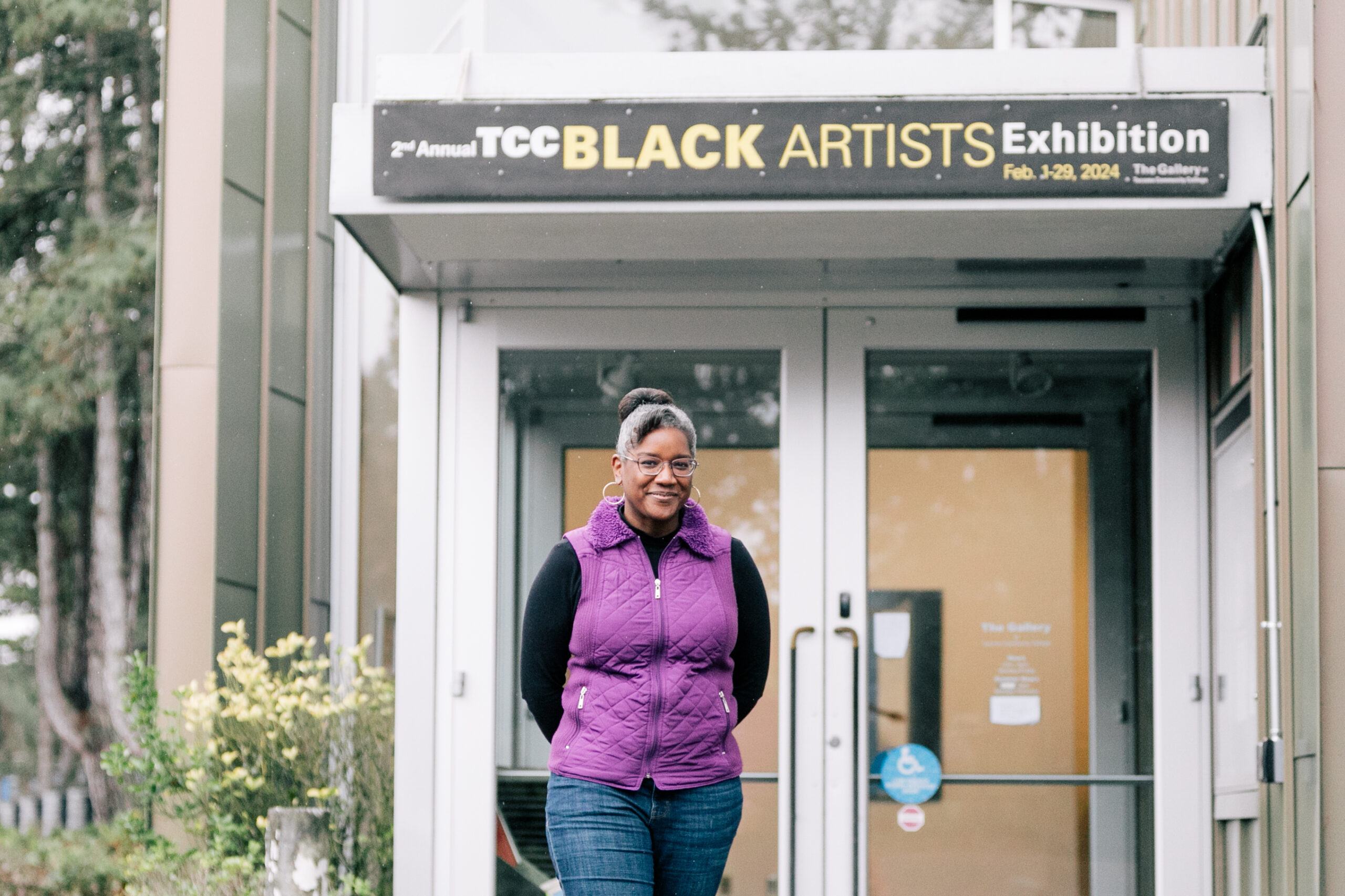
We are sharing this blog during Women’s History Month, and last month was Black History Month. How has your identity influenced your work as an artist, teacher, art therapist, or otherwise?
As a Black woman and teaching artist, my identity profoundly influences my work in art and education. I approach my art and teaching with a deep sense of authenticity and personal resonance, creating work that reflects my own image and interests, drawing inspiration from the richness and diversity of my personal experiences as a Black woman.
As a teacher, I strive to impart lessons with compassion and empathy, drawing from my own experiences to guide and inspire my students. I believe in creating a nurturing and inclusive learning environment where students feel seen, heard, and valued for who they are. I aim to empower students to embrace their unique voices and perspectives, fostering a sense of confidence and self-expression in their artistic endeavors.
Overall, my identity informs every aspect of my work, contributing to the diverse tapestry of voices in the arts community.”
A circular mirror that reflects Valencia is seen on the left side of the image, Valencia is painting with the painting in front of her, photographed over her shoulder.
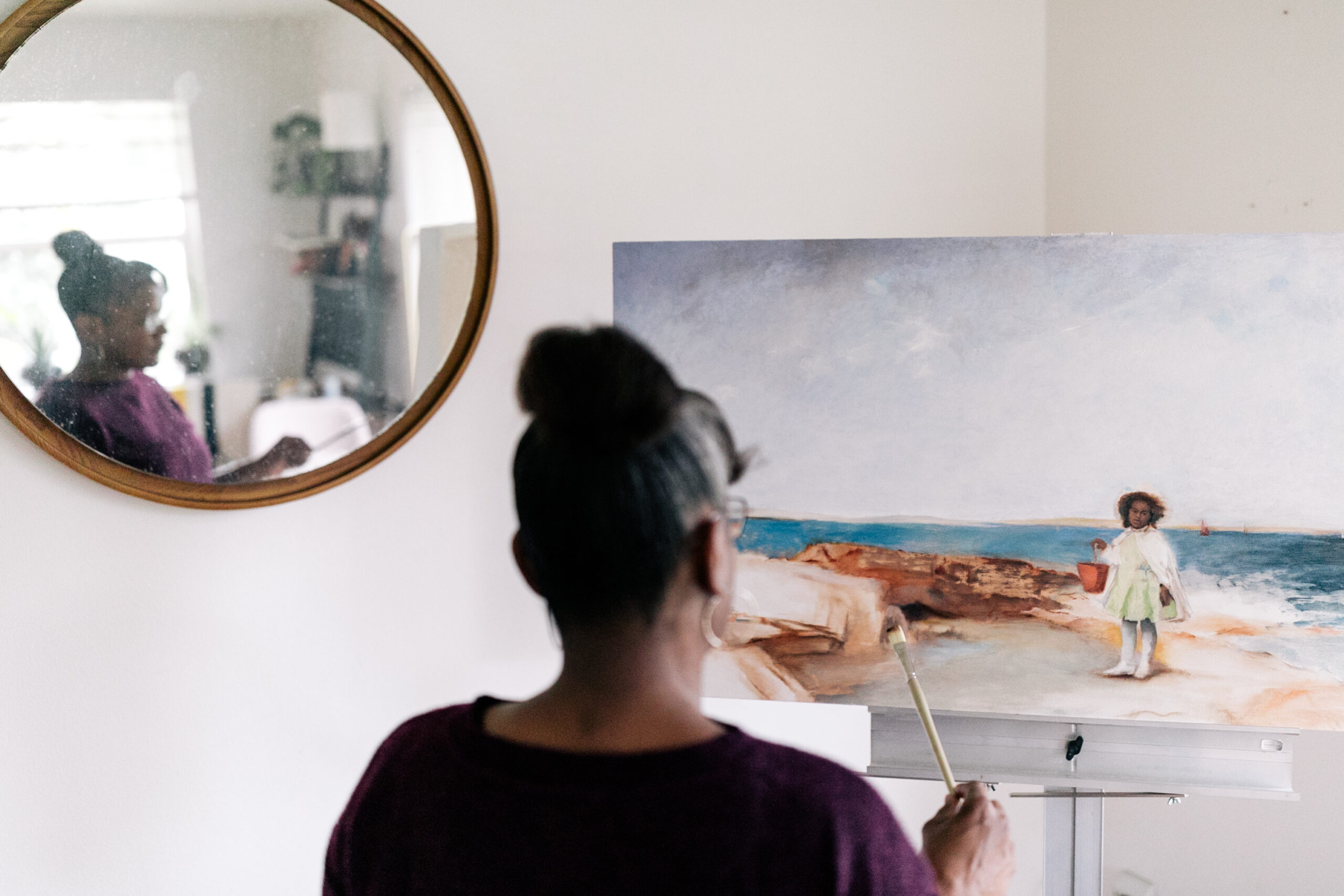
What advice would you give to aspiring artists or individuals interested in pursuing a career in art based on your own experiences and journey?
My advice to aspiring artists or individuals interested in pursuing a career in art is to prioritize practice, perseverance, and bravery. Dedicate yourself to honing your craft through consistent practice and experimentation. Remember that there are no shortcuts to achieving your artistic goals, so be patient and give yourself the time and space to fully develop your skills and vision.
It’s essential to be brave in creating your own path and embracing your unique voice as an artist. Don’t be afraid to take risks, try new techniques, and explore unconventional ideas. Showing up and putting in the effort is key – success in the art world often comes down to hard work and persistence.
It’s also important to recognize that rejection is a natural part of the artistic journey. Instead of viewing rejections as setbacks, see them as opportunities for growth and learning. Use them as motivation to keep pushing forward and refining your craft. Rejections are just speedbumps on the road to your success.
Ultimately, trust in yourself and your abilities, and stay true to your artistic vision. Stay resilient in the face of challenges and setbacks, and never stop believing in the power of your creativity to make an impact in the world.
Valencia is wearing a purple sweater and is sitting in front of an oil painting she is working on, she is holding her paintbrush and paint palette. There are roses and painting supplies sitting on a table beside her.
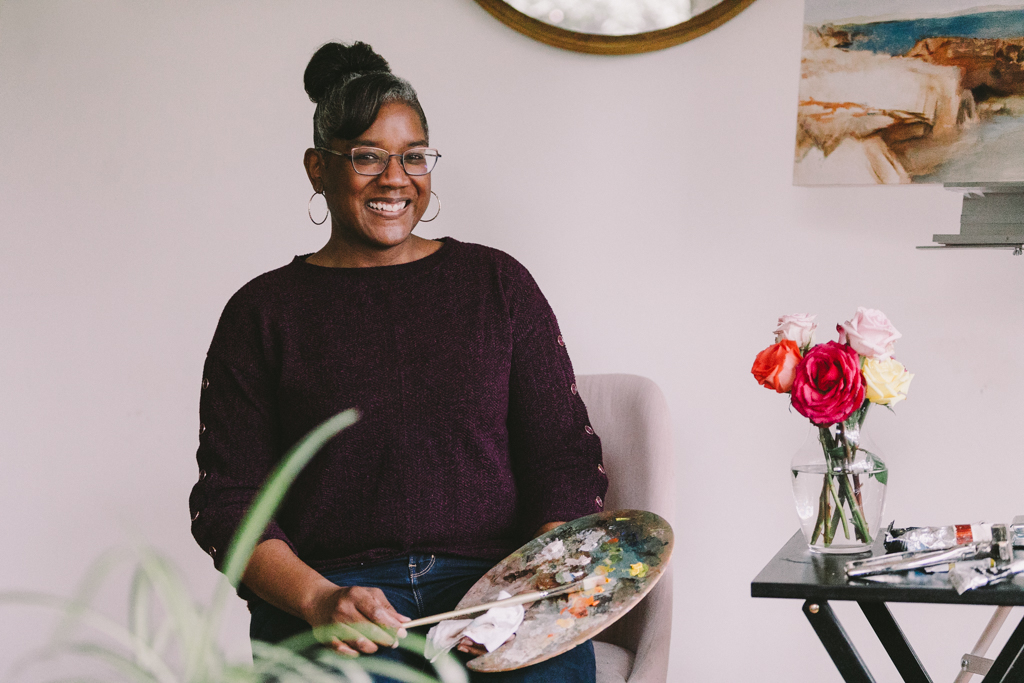
What motivated you to work with Urban ArtWorks, and how has your experience been as a teaching artist with the organization?
I was motivated to work with Urban ArtWorks by a deep-seated passion for both art and community engagement. The organization’s commitment to creating public art projects that not only beautify urban spaces but also empower young artists resonated deeply with me. Inspired by my own experiences as an artist and art therapist, I was eager to contribute to projects that fostered creativity, collaboration, and positive social impact.
My journey as an artist and mentor began during high school when I had the opportunity to intern at the local marine museum. Under the guidance of my mentor, I was inspired to pursue art professionally and saw firsthand the impact of mentorship on personal and artistic growth. This experience instilled in me a desire to pay it forward and become a mentor to high school students, just as my mentor had done for me.
My experience as a teaching artist with Urban ArtWorks has been incredibly fulfilling and rewarding. Working alongside talented young artists, I’ve had the opportunity to witness firsthand the transformative power of art in communities. Guiding students through the process of creating public art has been both challenging and inspiring. From brainstorming ideas to executing large-scale murals, I’ve seen students grow in confidence, creativity, and resilience.
One of the most rewarding aspects of my experience has been witnessing the impact of our projects on the community. Seeing the joy, pride, and sense of ownership that our artwork brings to others has been truly gratifying. Urban ArtWorks provides a platform for young artists to share their voices, stories, and talents with the world, and I feel privileged to be a part of that journey.
Overall, my experience as a teaching artist with Urban ArtWorks has reaffirmed my belief in the power of art to inspire change and foster connections within communities. I am grateful for the opportunity to mentor the next generation of artists and contribute to the vibrant urban art scene.
How do you approach teaching art to students, and what aspects of the creative process do you find most rewarding to share with them?
My approach to teaching art to students is rooted in fostering a sense of experimentation and play. I encourage students to explore their creativity freely, to take risks, and to embrace the process of art-making without fear of making mistakes. By creating a supportive and non-judgmental environment, I aim to empower students to trust their instincts and to discover their unique artistic voices.
One of the most rewarding aspects of teaching art is witnessing students’ understanding that mistakes are not failures but rather essential steps in the creative process. When students embrace the idea that mistakes are opportunities for learning and growth, they become more resilient and confident in their abilities as artists. Seeing their confidence grow as they overcome challenges and push the boundaries of their creativity is incredibly gratifying.
Moreover, I find great joy in sharing the excitement of discovery with students as they explore new techniques, experiment with different mediums, and express themselves through art. Witnessing students’ faces light up with enthusiasm and pride as they uncover the endless possibilities of artistic expression – whether it’s through mixing paint to create a specific hue or refining the size and shape of an object in their artwork – is truly rewarding. Ultimately, my goal as a teacher is to inspire and empower students to find joy, meaning, and fulfillment through art, both in the classroom and beyond.


